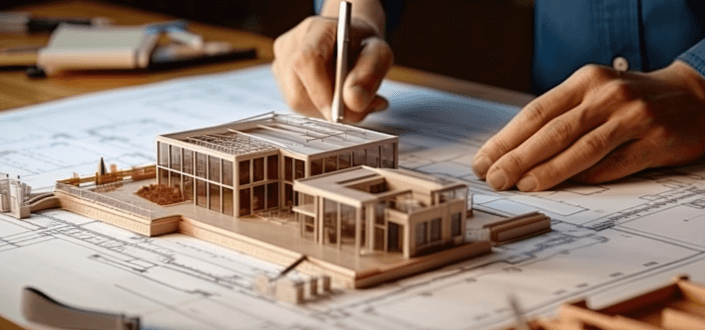How to Choose the Best Architectural Firm

Choosing the right architectural firm is a critical decision that can significantly influence the success of your construction project. Whether you’re planning to build a new home, remodel an existing property, or develop a commercial space, the architectural firm you select will play a central role in transforming your vision into reality. With so many firms to choose from, how do you ensure you’re making the best choice?
This guide will walk you through the key steps, considerations, and expert tips on how to choose the best architectural firm for your needs. By the end, you’ll be equipped with the knowledge to make an informed decision that aligns with your goals and ensures a smooth and successful project.
Understanding the Role of an Architectural Firm
Before diving into the selection process, it’s essential to understand what an architectural firm does and why their expertise is crucial to your project. An architectural firm is responsible for designing buildings and structures, ensuring they are functional, safe, aesthetically pleasing, and compliant with local regulations. They take your ideas and transform them into detailed plans, manage the design process, and often oversee the construction phase.
Architectural firms typically offer a range of services, including:
- Conceptual design
- Detailed architectural drawings
- Project management
- Interior design
- Landscape design
- Building code compliance
Understanding the scope of services offered by an architectural firm can help you determine what you need and how to evaluate potential firms.
Assessing Your Project Needs
The first step in choosing the best architectural firm is to clearly define your project needs. What type of project are you undertaking? Is it residential, commercial, or industrial? Are you looking for a contemporary design, a historic renovation, or something entirely unique? Understanding your project’s scope, complexity, and specific requirements will help you identify firms that specialize in the type of work you need.
Consider the following when assessing your project needs:
- Project Type: Are you building a new home, renovating an office space, or developing a mixed-use building?
- Design Style: Do you prefer modern, traditional, minimalist, or eclectic designs?
- Budget: What is your overall budget, and how much can you allocate to architectural services?
- Timeline: What is your desired completion date, and how flexible are you with the timeline?
By answering these questions, you’ll have a clearer idea of what you’re looking for in an architectural firm, which will make the selection process more focused and efficient.
Researching Architectural Firms
Once you’ve defined your project needs, the next step is to research architectural firms that align with your requirements. Start by gathering recommendations from trusted sources such as friends, family, or colleagues who have completed similar projects. Online platforms like Houzz, the American Institute of Architects (AIA), and local business directories can also be valuable resources for finding reputable firms.
When researching firms, consider the following:
- Experience: How long has the firm been in business? Do they have experience with projects similar to yours?
- Portfolio: Review the firm’s portfolio to assess the quality and style of their work. Does their design approach resonate with your vision?
- Reputation: Check online reviews and testimonials to gauge client satisfaction. Has the firm received any industry awards or recognition?
- Size of Firm: Consider whether you prefer a large firm with extensive resources or a smaller firm that may offer more personalized service.
By thoroughly researching potential firms, you can create a shortlist of candidates that meet your criteria.
Evaluating Qualifications and Expertise
Not all architectural firms are created equal, so it’s essential to evaluate the qualifications and expertise of each firm on your shortlist. Key factors to consider include:
- Licensing and Accreditation: Ensure the firm is licensed to practice architecture in your state or country. Membership in professional organizations like the AIA can also be a sign of credibility.
- Specializations: Some firms specialize in specific types of projects, such as residential, commercial, or sustainable design. Make sure the firm has experience relevant to your project.
- Technical Expertise: Assess the firm’s knowledge of building codes, regulations, and construction methods. A firm with strong technical expertise can help you avoid costly mistakes and delays.
- Design Philosophy: Every firm has a unique design philosophy. Do they prioritize functionality, sustainability, or aesthetics? Choose a firm whose philosophy aligns with your goals.
In addition to these factors, consider the firm’s approach to problem-solving and innovation. A firm that embraces creativity and flexibility can offer solutions that enhance the overall outcome of your project.
Meeting with Potential Firms
After narrowing down your list of potential firms, the next step is to arrange meetings or consultations. This is your opportunity to get to know the architects, discuss your project in detail, and determine whether they are the right fit. During these meetings, pay attention to the following:
- Communication Skills: Effective communication is crucial in any architectural project. Does the firm listen to your ideas and concerns? Are they able to clearly explain their design process and approach?
- Collaboration: A successful project often involves collaboration between the architect, client, contractors, and other stakeholders. How does the firm handle collaboration? Are they open to feedback and willing to work closely with you?
- Understanding of Your Vision: Does the firm understand and share your vision for the project? Are they enthusiastic about bringing your ideas to life?
- Transparency: Ask about the firm’s fee structure, contract terms, and project management approach. Transparency in these areas can prevent misunderstandings later on.
These meetings are also an opportunity to assess the firm’s personality and culture. You’ll be working closely with the architects for an extended period, so it’s important to choose a firm with whom you feel comfortable and confident.
Reviewing Proposals and Contracts
Once you’ve met with several firms, ask them to provide a detailed proposal for your project. The proposal should outline the scope of work, timeline, fee structure, and any additional services the firm will provide. Review these proposals carefully, comparing them against your project needs and budget.
Key elements to review in the proposal include:
- Scope of Work: Does the proposal cover all aspects of your project, from initial design to construction oversight?
- Fee Structure: Is the fee structure clear and transparent? Are there any potential hidden costs?
- Timeline: Does the proposed timeline align with your desired completion date? Are there any contingencies for delays?
- Deliverables: What deliverables will the firm provide at each stage of the project? This may include conceptual designs, detailed drawings, permits, and final inspections.
Before signing a contract, ensure that all terms are clearly defined and that you understand the firm’s responsibilities and your own. If necessary, seek legal advice to review the contract.
Considering the Firm’s Design Process
The design process is a critical aspect of any architectural project. Each firm has its own approach to design, which can impact the outcome of your project. When choosing an architectural firm, consider how they approach the design process:
- Conceptual Design: How does the firm develop initial design concepts? Do they incorporate your ideas and preferences?
- Client Involvement: How involved will you be in the design process? Will you have opportunities to provide feedback and make decisions?
- Flexibility: Is the firm open to making changes or adjustments to the design as the project progresses?
- Visualization Tools: Does the firm use 3D modeling, virtual reality, or other tools to help you visualize the design?
A firm that involves you in the design process and provides clear, visual representations of the project can help ensure that the final design meets your expectations.
Understanding Project Management and Oversight
Effective project management is essential for the successful completion of any architectural project. The best architectural firms not only excel in design but also in managing the entire process from start to finish. When evaluating firms, consider their approach to project management:
- Coordination with Contractors: How does the firm coordinate with contractors, engineers, and other professionals involved in the project?
- Construction Oversight: Will the firm provide on-site supervision during construction to ensure the design is executed correctly?
- Problem-Solving: How does the firm handle unexpected issues or challenges that arise during construction?
- Regular Updates: Will the firm provide regular updates on the project’s progress? How do they communicate any changes or delays?
A firm with strong project management skills can help you navigate the complexities of construction, avoid delays, and ensure the project stays on budget.
Evaluating the Firm’s Sustainability Practices
Sustainability has become an increasingly important consideration in architecture. If sustainability is a priority for your project, it’s essential to choose a firm with expertise in green building practices. Evaluate the firm’s commitment to sustainability by considering the following:
- Experience with Sustainable Design: Does the firm have experience designing energy-efficient, eco-friendly buildings?
- LEED Certification: Is the firm familiar with LEED (Leadership in Energy and Environmental Design) standards? Have they completed any LEED-certified projects?
- Material Selection: How does the firm approach the selection of sustainable materials? Do they prioritize locally sourced, recycled, or low-impact materials?
- Energy Efficiency: What strategies does the firm use to enhance energy efficiency in their designs, such as passive solar design, insulation, and renewable energy systems?
Choosing a firm with a strong track record in sustainability can help you achieve your environmental goals while reducing long-term operational costs.
Assessing the Firm’s Portfolio
A firm’s portfolio is a window into their capabilities, style, and design sensibilities. Reviewing the portfolio allows you to assess whether their previous work aligns with your vision. When evaluating a portfolio, consider:
- Variety of Projects: Does the portfolio showcase a range of projects, or is it limited to a specific type or style?
- Consistency in Quality: Are all projects in the portfolio of consistent quality, or do some stand out more than others?
- Design Versatility: Does the firm demonstrate versatility in their design approach, or do they stick to a particular aesthetic?
- Client Testimonials: Are there any client testimonials or case studies that provide insight into the firm’s process and client satisfaction?
A well-rounded portfolio with a variety of successful projects is a strong indicator of a firm’s expertise and reliability.
Budget Considerations
Budget is often one of the most significant factors in choosing an architectural firm. It’s important to find a firm that can deliver high-quality work within your financial constraints. When discussing budget with potential firms, consider:
- Fee Structure: Does the firm charge a fixed fee, hourly rate, or percentage of the project cost? Make sure the fee structure is transparent and aligns with your budget.
- Cost Estimates: Does the firm provide accurate cost estimates? How do they handle potential cost overruns?
- Value for Money: Does the firm offer good value for the services provided? Are there any areas where you can save costs without compromising quality?
- Payment Schedule: What is the payment schedule? Are there any upfront costs or deposits required?
Balancing quality with cost is key to ensuring you get the best outcome for your investment.
Finalizing Your Decision
After thoroughly researching, meeting with potential firms, and reviewing proposals, it’s time to make your final decision. Choose the firm that best meets your criteria, aligns with your vision, and demonstrates the expertise needed to bring your project to life. Trust your instincts—if a firm feels right, it likely is.
Once you’ve selected a firm, finalize the contract, and begin the exciting journey of transforming your ideas into reality. Remember that the best architectural firm will not only deliver a beautiful design but also provide a smooth, collaborative, and enjoyable experience throughout the project.
FAQs
How do I know if an architectural firm is reputable? Look for licensing, industry awards, client testimonials, and membership in professional organizations like the AIA. Checking online reviews and speaking with previous clients can also provide insight into the firm’s reputation.
What should I ask during my first meeting with an architectural firm? Ask about the firm’s experience with similar projects, their design process, how they handle project management, and their approach to budgeting. It’s also important to discuss your vision and see if the firm is enthusiastic about your ideas.
How important is it to choose a firm with experience in my specific type of project? Experience with similar projects is highly beneficial, as it means the firm is familiar with the specific challenges and requirements. However, if a firm has strong overall expertise and a versatile portfolio, they may still be a good fit.
Can I negotiate the fee structure with an architectural firm? Yes, you can discuss and negotiate the fee structure. Some firms may be willing to adjust their fees based on the project’s scope, budget, or other factors. Ensure that any changes are clearly reflected in the contract.





